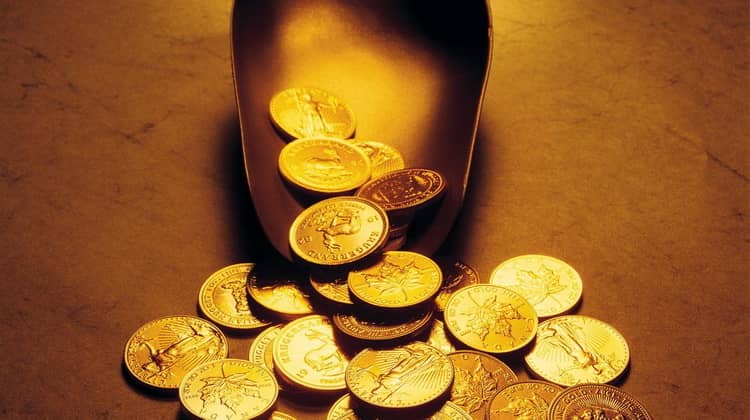
Antique gold coins of Austria are especially attractive to collectors. Not only because of their high cost but mostly because of their historical value. All coins of this type can be divided into four groups: ducats, florins, coronas, and shillings. This process was mainly influenced by the political and economic changes that took place in Austria in different time periods.
Gold ducats
1 ducat denomination
- Year of minting: 1589
- Weight: 3.48 g
- Diameter: 22.5 mm
- Obverse: Rudolph II with a scepter and orb in his hands surrounded by the dotted line; inscription «S A*G*H*B*REX*RVDOL*II*D:G*R*I»; dotted line decoration.
- Reverse: coat of arms of the empire with a crown framed by a chain with the Order of the Golden Fleece; inscription «*ARCHID*AVS*DV BVR*MA*MO*1589*»; dotted line decoration.

1 ducat denomination
- Year of minting: 1871
- Weight: 3.49 g
- Diameter: 20 mm
- Obverse: Franz Joseph I with a laurel wreath on his head; inscription «FRANC*IOS*I*D*G*AVSTRIAE IMPERATOR»; dotted line decoration.
- Reverse: two-headed eagle with three crowns and the coat of arms of the Austrian empire instead of the trunk, royal regalia in its clutches; inscription «LOD*ILL*REX A*A*1871 HVNGAR*BOHEM*GAL*»; dotted line decoration.
Austrian 1 Ducat 1871 gold coins in GoldAdvert catalog.
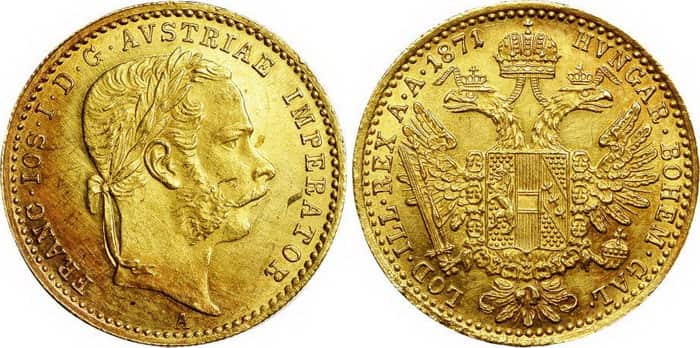
Gold florins
4 florin denomination
- Year of minting: 1892
- Weight: 3,2258 g
- Diameter: 17 mm.
- Obverse: Franz Joseph I with a laurel wreath on his head; inscription «FRANCISCVS*IOSEPHVS*I*D*G*IMPERATOR*ET*REX*»; dotted line decoration.
- Reverse: two-headed eagle with three crowns and with the coat of arms of the Austrian empire instead of the trunk, royal regalia in its clutches ; inscription «IMPERIVM AVSTRIACVM»; denomination and year of minting at the bottom; dotted line decoration.
Austrian 4 Florins 1892 gold coins in GoldAdvert catalog.
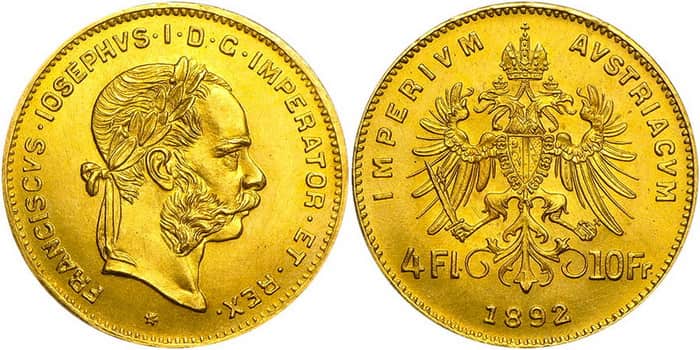
Gold coronas
20 corona denomination
- Year of minting: 1915
- Weight: 6.0962 g
- Diameter: 21 mm
- Obverse: Franz Joseph I; inscription «FRANC*IOS*I*D*G*IMP*AVSTR*REX BOH*GAL*ILL*ETC*ET AP*REX HVNG*»; dotted line decoration.
- Reverse: two-headed eagle with three crowns and with the coat of arms of the Austrian empire instead of the trunk, royal regalia in its clutches ; inscription «XX CORONAE MDCCCCXV»; denomination and year of minting at the bottom; dotted line decoration.
Austrian 20 Coronas 1915 gold coins in GoldAdvert catalog.
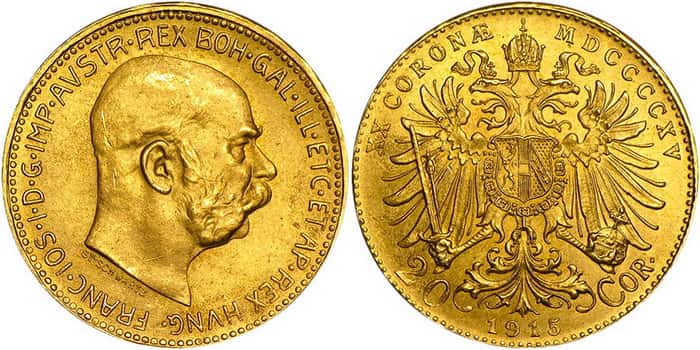
Interesting fact: Just like 10 and 100 corona denominations, 20 Austro-Hungarian corona (1892-1914) has an anniversary coin version, issued in 1908 and dedicated to the 60th anniversary of the reign of Franz Joseph I. It was in circulation and was a legitimate mean of payment with others commemorative coins of that year.
100 corona denomination
- Year of minting: 1908
- Weight: 6.096 g
- Diameter: 21 mm
- Obverse: portrait of Franz Joseph I; inscription «FRANC*IOS*I*D*G*IMP*AVSTR*REX BOH*GAL*ILL*ETC*ET AP*REX HVNG*»; dotted line decoration.
- Reverse: woman sitting on a cloud with a laurel wreath in her right hand; shield with the coat of arms under her left hand; period of the 60-year rule of Franz Joseph I and the face value at the edge; horizontal inscription «DVODECIM LVSTRIS GLORIOSE PERACTIS» at the bottom; dotted line decoration.
Austrian 100 Coronas 1908 gold coins in GoldAdvert catalog.
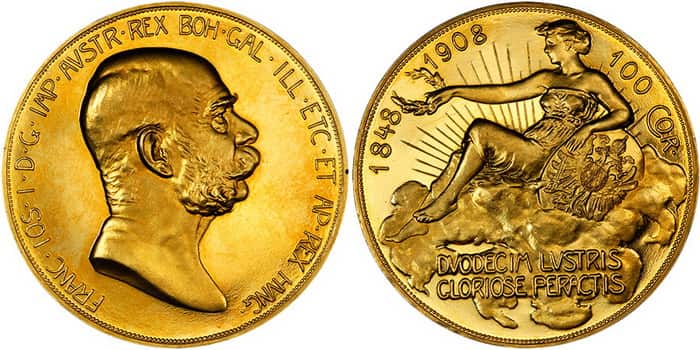
Gold shillings
100 shilling denomination
- Year of minting: 1928
- Weight: 23.53 g
- Diameter: 33 mm
- Obverse: two-headed eagle with a crown on its head and a shield instead of the trunk; sickle and hammer in its clutches; inscription «REPUBLIK OSTERREICH»; dotted line decoration.
- Reverse: face value in the center; year of minting framed by two stars; olive tree twigs on both sides of it; wavy design bordering at the edge.
Austrian 100 Shilings 1928 gold coins in GoldAdvert catalog.

What coins were in circulation
In the history of Austria, there were several periods when gold coins of different types and denominations were issued
- Gold ducats had been minted since 1284. These were coins made of gold with a fineness of 980 and 3.5 g weight.
- Gold florins had been minted since 1870 in only two denominations. The weight of 4 gold florins was 3.2 g, and the weight of 8 gold florins was 6.5 g.
- Gold coronas with a fineness of 900 and 950 (including those with an addition of copper and zinc) were minted since1892:
20 coronas of 6.7751 g were minted between 1923 and 1924, 100 coronas of 33.8753 g – in the period of 1923-1924, 100 coronas of 1.666 g – in the period of 1923-1924, 200 coronas of 3.33 grams – in 1924 and 1.000 coronas of 4.5 grams – in 1924.
- Gold shillings with a fineness of 900 with an addition of copper began to mint since 1926: 25 shillings of 5.9 grams – in 1926, 100 shillings of 23.5 grams in 1926 and 100 commemorative shillings “Magna Mater Austriae” of 23.5 grams – in 1935.
Which mints minted
The Austrian mint issued gold coins of all periods in Vienna. It was called the Vienna Mint until 1989. The history of its creation dates back to the historical event when in 1194 the Archduke of Austria Leopold V captured Richard the Lionheart, who bought his freedom for 12 tons of silver. Such a vast amount of precious metal had to be used somehow, and Leopold V gave the order to mint coins from it. Since then, the production of coins has not stopped, and not only silver but also gold was used for coinage.
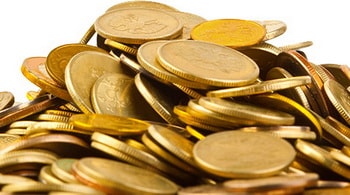
Until 1918, the Mint of Austria had five more branches in other cities of the empire, but after its collapse, only the Vienna Mint remained. Today it is also the only one in Austria, and it works in tandem with the National Bank.
The cost of coins on the market
The value of ancient gold coins in Austria can be completely different since it depends on many factors:
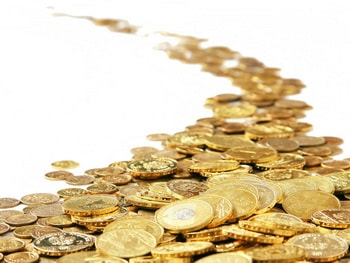
- The price of gold for one troy ounce on the world stock exchanges of precious metals on the day of purchase/ sale;
- the amount of pure gold in a coin;
- minting period;
- rareness;
- condition;
- demand on the market.
For example, the price for 4 florins of 1892 can reach 925 euros, and one ducat of 1848 can have a price ranging from 135.5 US dollars to 800 US dollars. However, there are such rare specimens, the price of which reaches several thousand dollars.
Interesting facts
- A worker in Austro-Hungary with an average qualification received a salary of approximately 400-500 florins; the teacher – up to 1,000 florins.Officials of the Imperial Ministry of Foreign Affairs earned no less than 4,000 florins in 1880.
- In 1914, most of the Austria-Hungarian state capital, which was 6 billion coronas, belonged to Germany, and 3 billion coronas – to France
- In the memoirs of Grand Duke Mikhail Romanov, you can find the words of the adjutant Mordvinov, who accompanied Prince Petr Aleksandrovich Oldenburgsky to Carlsbad for treatment in 1907. It said: “The consultation of Professor Norden, which lasted about 20 minutes, cost the Grand Duke a high price – 10,000 coronas, which included the cost of travel, and the cost of living in Vienna for two days.”
Comments
No commens yet.